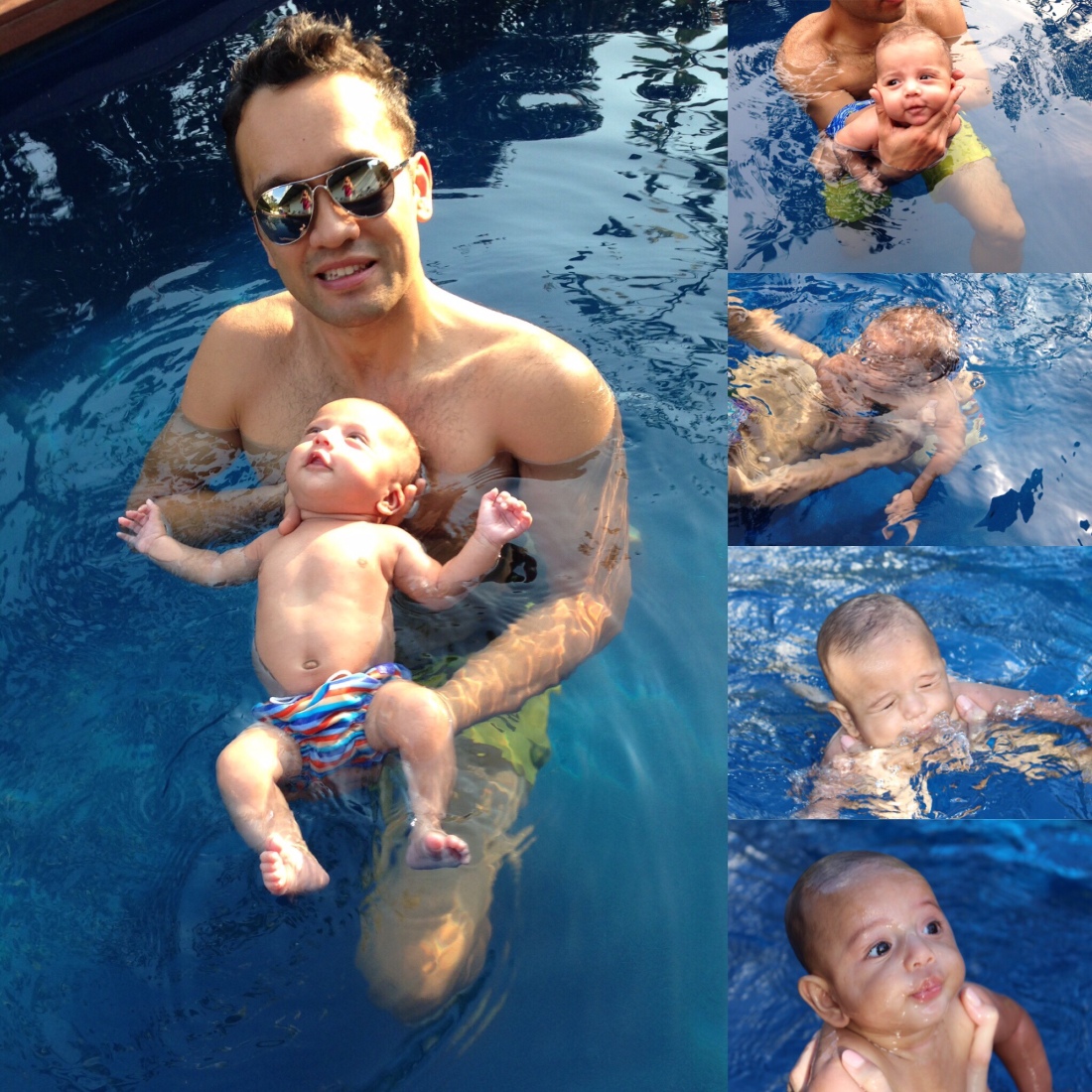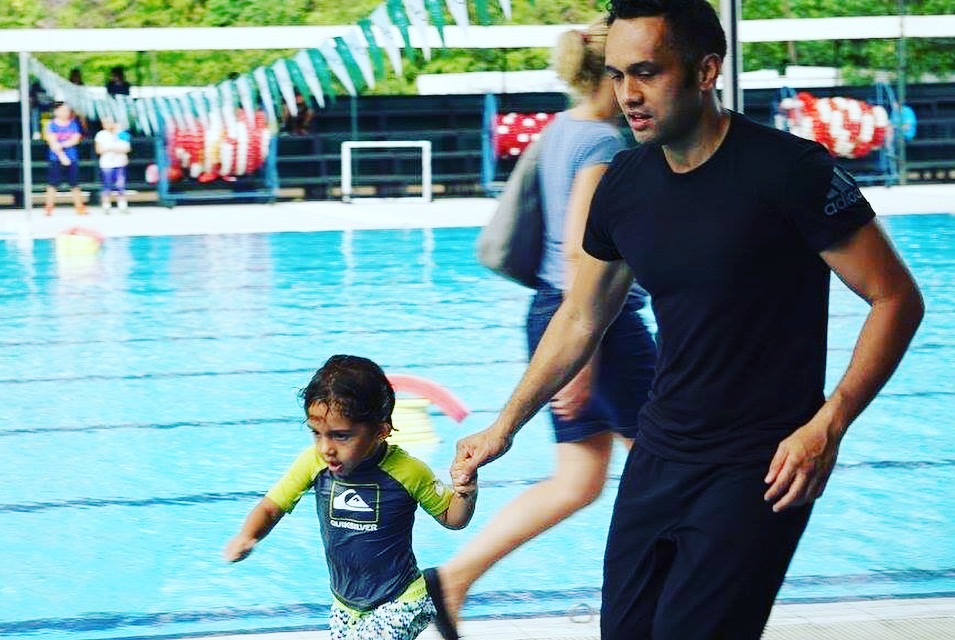From Sol’s very first bath experience at home, he relaxed. He could have been one of those infants that fall asleep in the water. If you think about it, you’re swimming around inside your mother’s tummy for 9 months, it’s all warm and cosy in there and you don’t have to navigate the sensation of gravity and then BAM, you’re born into the cold light of day with noise and people and NO WATER!
When I would bath Sol, I would pour water over his face, just to, you know, see what would happen. Even as I write the sentence, I’m thinking someone will interpret this to mean I was trying to drown my infant. But I did it because my gut instinct said a baby loves water and they are used to this.
We have a swimming pool at home and living in a tropical country, you can swim all day every day. It would be natural that our kids would be swimming from a young age and there is that fear they might just toddle outside and jump in the pool by themselves and then we would be a statistic. Note this – it is NOT a law to have barriers around pools in Malaysia. Most home swimming pools are “in ground” which means you can open your door and jump right in. This is great if everyone can swim but a hazard when you have crawling babies and toddling toddlers – unless they can swim of course!
Two of my former bosses were swim coaches before they were CEO’s – as I write that I ponder on the coincidence. Actually, it is just a coincidence because one is a really great person and the other…..not as great. And they both shared with me their insights into the benefits of swimming from a young age. We are talking about 6 week-old infants starting to swim. You’ve seen the cool YouTube videos of babies naturally swimming under the water, popping up and taking a breath before diving in again. This is what we did with Sol. I DID seek a professional opinion and research the “when/how/what/why” of teaching an infant to swim before attempting this at home. If you are interested in finding out the “HOW”, drop me an email and I’ll describe to you how we taught Sol to swim from 6 weeks old.

From the pictures above, you can see he is under the water and his eyes and mouth are closed and as he comes up through the water, he is perfectly OK with it. The photo you don’t see is the beaming smile every time he comes up. And that’s because he was pretty young. As time went on, this little fish would start squeeling and kicking to get into the pool. Once he was in the water, it was like he was HOME.
Hippocampal Neurogenisis is the crazy name for ongoing development of the nerves, motor neurons and brain in relationship to movement. When it comes to swimming, here are the things I’ve learnt:
- Swimming can boost blood flow to the brain by up to 14% giving improved mood, better concentration, focus and cognitive function.
- Swimming improves gross and fine motor skills and connects the two brain hemispheres improving bilateral movement, and the ability to learn. This is especially true for kids with special needs and/or dyspraxics – BOOM!
- Swimming promotes hippocampal neurogenesis in the regrowth of brain cells in areas of atrophy – in a previous post I wrote how Sol’s right cerebellum was 30% smaller than the left side.
From a Mum’s observation, the benefits of swimming to Sol’s confidence, sense of joy and socialisation make it all worthwhile. Sol will probably not be that kid that plays rugby on the A-team (or D-team), so having a physical activity that he can do well, and he feels good about, will maintain a high level of self esteem and confidence. When Sol swims, it’s like the sun shines brighter – his smile as soon as his body hits the water is a joy to behold. The removal of gravity for Sol is pure relief for him. Not having to negotiate bumpy pathways, sharp corners or people telling him to hurry up would be equivalent to a drug high. In the pool, Sol has a “level playing field” with other kids. He’s happy, so he’s having fun and often initiating the activities and encouraging other kids to swim along with him.
After an hour of swimming, Sol is relaxed and focused. He can draw or play by himself for an hour or more. Sol is now having formal swimming lessons – he is learning the front crawl OR freestyle as we call it in New Zealand. This is quite a challenge as he is required to alternate arms and take a breath on every second stroke. And keep his legs kicking. For a person with dyspraxia, this would be like a dancer being forced to dance “off the beat”. (Not so hard for my husband!). But he is working at it because he loves being in the water so much. Check this out! (Sol – 4.5 years)
Another symptom for dyspraxia is general fatigue. I know of some kids that literally fall asleep at their desk due to mental fatigue. The process of ALWAYS having to think about how your body moves or trying to remember what the teacher said first, after they said three things quickly, and then write that down would be equivalent to moving through mud while your brain is on hyperdrive. That’s right people – people with dyspraxia have average to high intelligence but I’m not going to write about that here. The point is, swimming has provided Sol with the ability to gain fitness and focus so he just DOESN’T.GET.TIRED – I occasionally wish he would but I know that his fitness is a GOOD thing. He doesn’t give up – he will always try.
I’m going to leave todays’ blog with a cool video and picture – Sol wake surfing with his dad (Dave) at 2.5 years old and his first duathlon at 4.5 years old. My little fish has my heart – hook, line and sinker.

so awesome babe! Luca swims without floats at 1 yr 6 months. Life is great when parents trust their instincts and teach their kids the benefits of not fearing the water early! Sol is a darling!! love the posts.. keep em coming..
LikeLike